Contact us
We are happy to answer questions about your animal or patient.
Contact: neurochirurgie@kleintier.de or l.matiasek@lmu.de
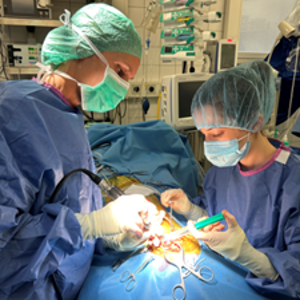
Neurosurgery covers diseases of the brain and bony skull, the spinal cord/spinal column and the peripheral nerves. The findings of the neurological examination form the basis for further diagnostics. In the field of neurosurgery, this primarily involves magnetic resonance imaging (MRI), computer tomography (CT) and, if necessary, muscle/nerve biopsy (after EMG/ electrodiagnostics).
Overview of diagnostic options and neurosurgical care:
Diagnostics:
- X-ray
- MRI (1.5 Tesla)
- CT (64-line)
- Muscle nerve biopsy after electrodiagnostics
- Brain biopsy
Neurosurgical care for spinal column/spinal cord and nerve (root) disorders:
- Herniated disc (cervical spine, thoracic/lumbar spine)
- Degenerative lumbosacral stenosis (cauda equina compression syndrome)
- Cervical spondylomyelopathy (Wobbler syndrome)
- Subarachnoid diverticula, cysts
- Instability (trauma: fracture, dislocation), congenital diseases (subluxation: atlantoaxial instability, malformations of the spine)
- Tumors
Neurosurgical care for brain diseases/diseases of the bony skull:
- Hydrocephalus (hydrocephalus)
- Malformations in the area of the skull and the anterior cervical spine (e.g. Chiari-like malformation)
- Subarachnoid cysts
- Tumors in the area of the brain (resection e.g. meningioma cat, cytoreduction) or bony skull (multilobular osteochondrosarcoma)
- Hypophysectomy
- Treatment of compressive fractures after traumatic brain injury
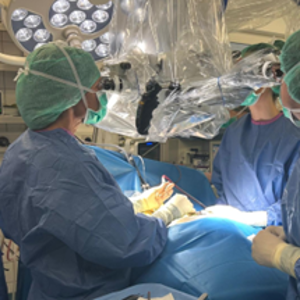
Operating microscope in neurosurgery | © Kleintierklinik der LMU
The use of our state-of-the-art neurosurgical operating microscope enables optimal visualization and the most precise neurosurgical procedure, even for complex neurosurgical interventions. If necessary, titanium meshes are used for reconstruction, particularly in head surgery. If necessary for stabilizing neurosurgical procedures, we offer surgical treatment using individualized titanium implants.
Close cooperation with our experienced anesthesia team and our intensive care specialists allows for optimal peri- and post-operative care. Our oncology team supports us with relevant issues, and hypophysectomy patients are cared for before and after the operation by our endocrinology department. Every post-operative neurosurgical patient receives individualized support from our physiotherapy and rehabilitation team.
Explanations of neurosurgical issues and examples from neurosurgery:
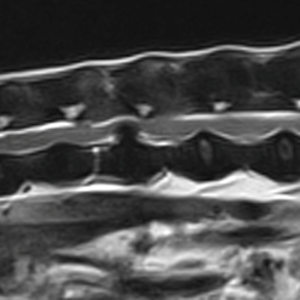
Herniated disc in a dog, Small Animal Clinic of the LMU
The most common neurosurgical diseases in dogs are herniated discs. However, these can also occur in cats. To confirm the diagnosis, an MRI is usually performed as the most sensitive method. Animals suffering from a herniated disc are usually treated by surgery if the herniation compresses the spinal cord.
Fractures in the area of the spine usually also require surgical treatment, as otherwise the spinal cord may be damaged, resulting in permanent neurological deficits. This is usually achieved using special screws, bone cement and/or plates.
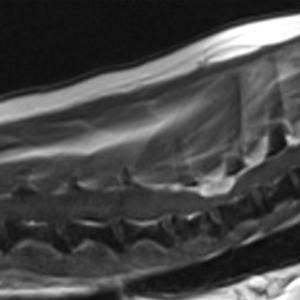
Spinal cord tumor in a dog, Small Animal Clinic of the LMU
Other spinal disorders that affect the spinal cord due to instability or compression are also treated by neurosurgery depending on the indication (e.g. degenerative lumbosacral stenosis, cervical spondylomyelopathy, atlantoaxial instability and other deformities).
In additionSpinal cord cysts (such as subarachnoid diverticula) and certain tumors in the area of the spinal column andperipheral nerves (plexus tumors) treated surgically.
Furthermore, tumor removal in the area of the brain (e.g. meningioma cat) or tumor biopsy/reduction (if not resectable) are performed in order to provide adequate further therapy recommendations (usually radiation) after a histological diagnosis has been made. From late-2025, we will also be offering hypophysectomy (removal of the pituitary gland) if it is tumorously altered in order to treat certain hormonal diseases such as Cushing's disease in dogs or insulin-resistant diabetes mellitus in cats.
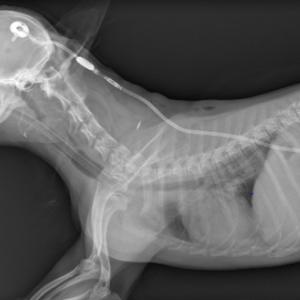
Ventriculoperitoneal shunt in a dog with hydrocephalus, Small Animal Clinic of the LMU
Surgical procedures on the brain include the implantation of a so-called shunt system for hydrocephalus (hydrocephalus), or surgical treatment of certain malformations in the area of the skull and the anterior cervical spine(e.g. Chiari-type malformation). Cystic changes in the area of the brain are also removed or drained.
If inflammatory changes are suspected, a tissue sample can be taken (brain biopsy) depending on the localization in the brain in order to follow up with appropriate medical treatment. We also offer neurosurgical treatment of compressive skull fractures following trauma.
If inflammatory changes are suspected, a tissue sample may be taken (brain biopsy), depending on the location in the brain, in order to initiate appropriate medical treatment. We also offer neurosurgical care for compressive skull fractures following trauma.
